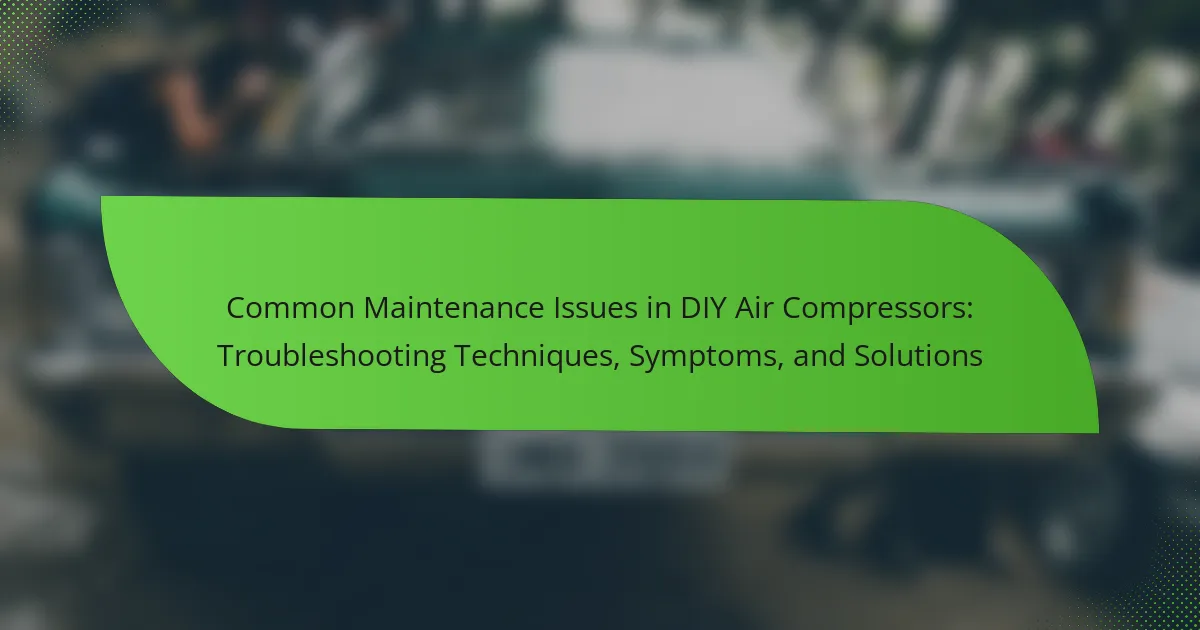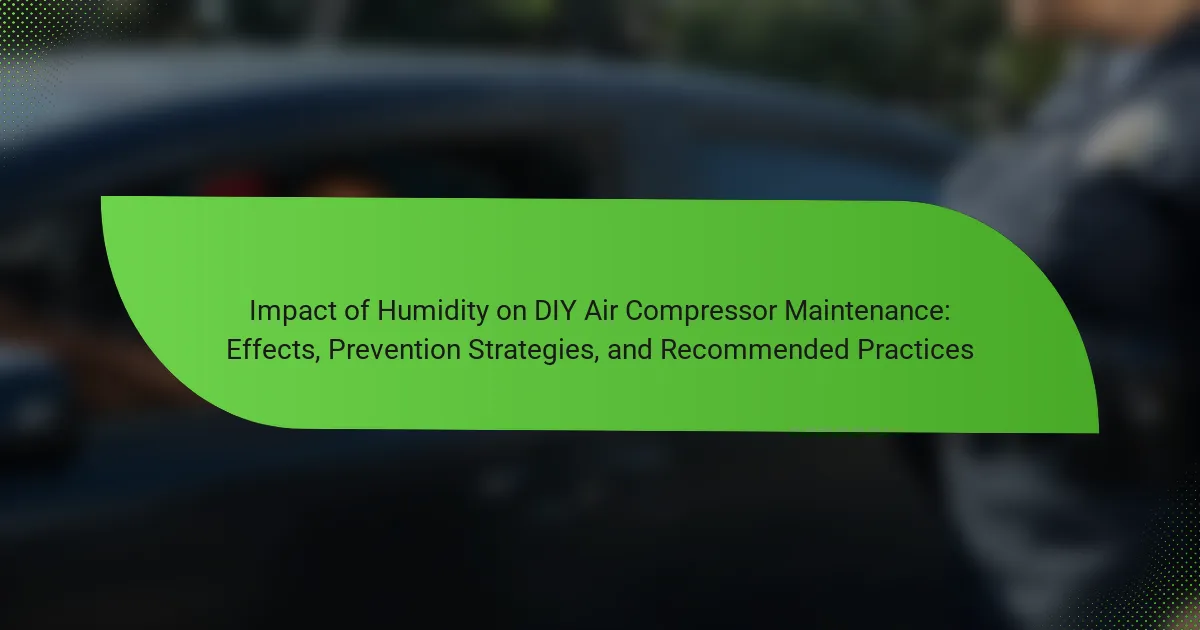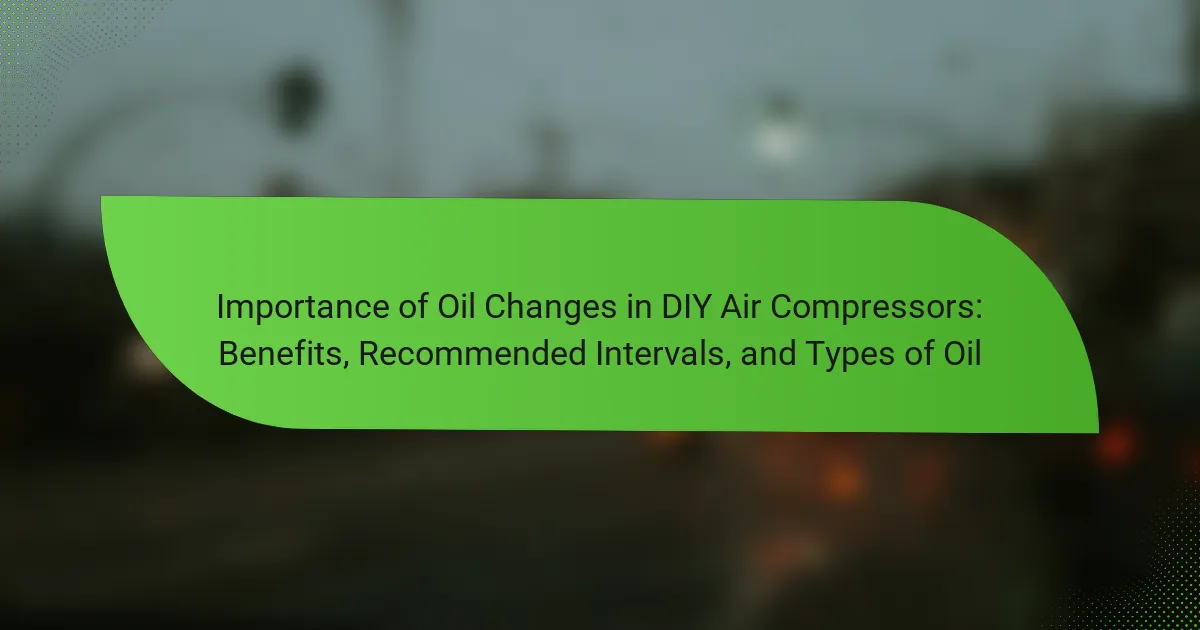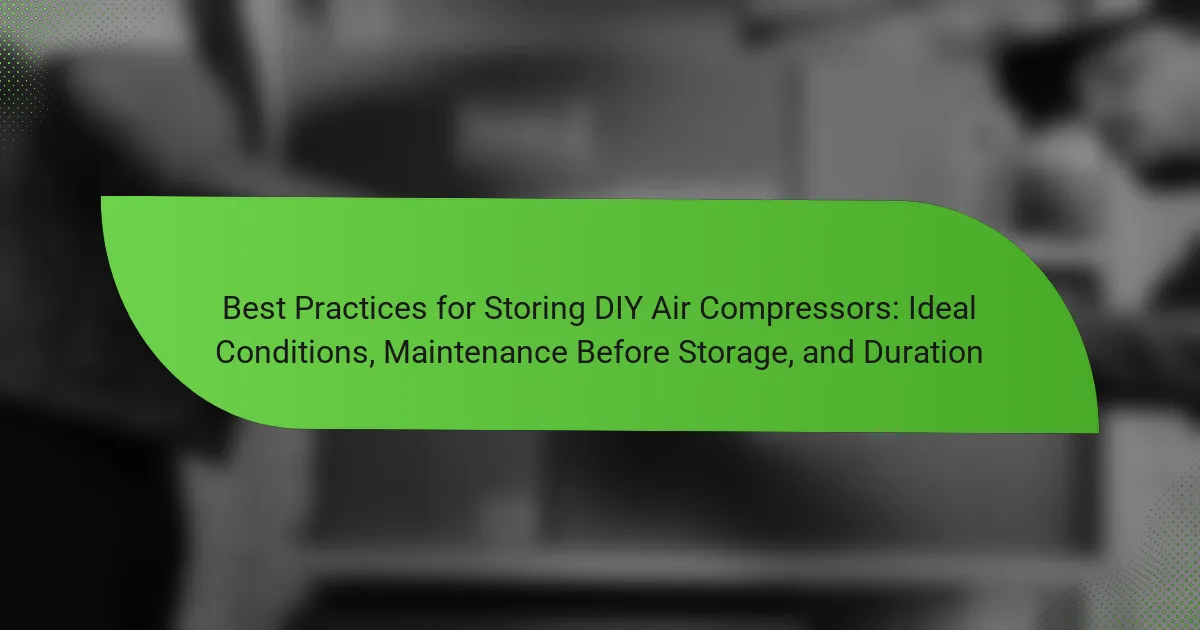The article focuses on the maintenance needs of DIY air compressors, highlighting key signs that indicate when maintenance is necessary. Common indicators include unusual noises, decreased pressure, oil leaks, frequent circuit breaker tripping, moisture buildup, and failure to start. The article outlines diagnostic steps for assessing air compressors, such as checking for air leaks, monitoring pressure gauges, and inspecting oil levels and air filters. It emphasizes the importance of timely actions, including addressing visible leaks, cleaning or replacing filters, and scheduling professional inspections to ensure optimal performance and extend the lifespan of the compressor.
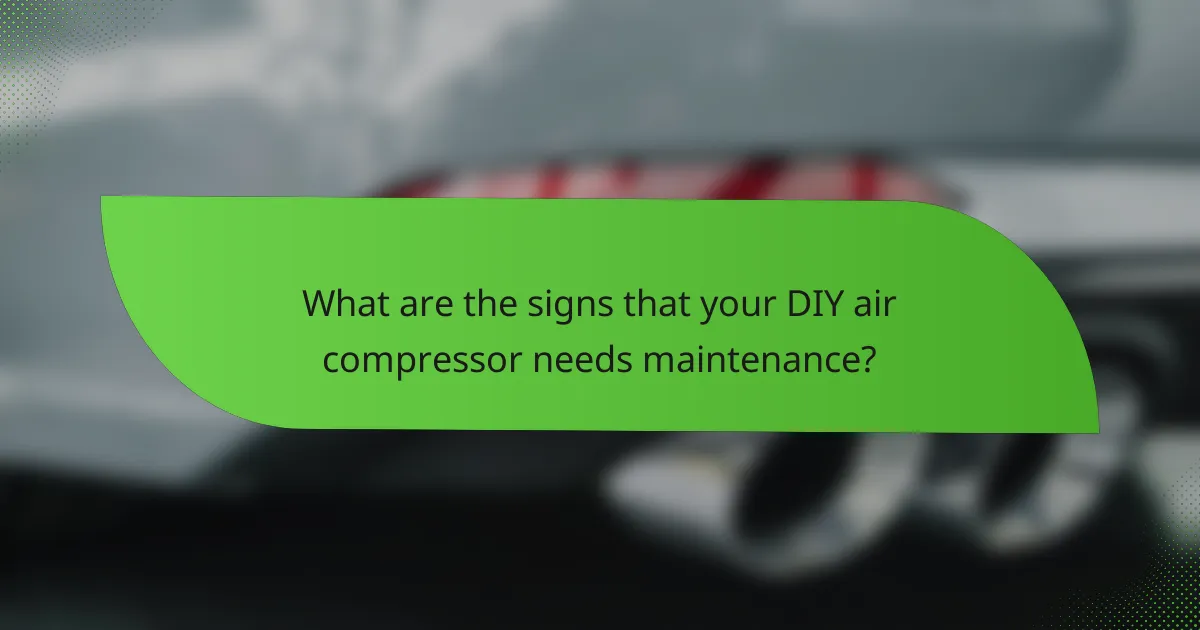
What are the signs that your DIY air compressor needs maintenance?
Signs that your DIY air compressor needs maintenance include unusual noises, decreased pressure, and oil leaks. Unusual noises may indicate worn components or loose parts. Decreased pressure can signal an air leak or malfunctioning regulator. Oil leaks often suggest seal failure or improper oil levels. Additionally, frequent tripping of the circuit breaker indicates electrical issues. A buildup of moisture in the tank can lead to corrosion. Lastly, if the compressor fails to start, it may require immediate attention. Regular inspections can help identify these signs early.
How can you identify common indicators of maintenance needs?
Common indicators of maintenance needs for a DIY air compressor include unusual noises, decreased pressure, and leaks. Unusual noises may indicate internal wear or damage. Decreased pressure can signal issues with the compressor’s efficiency. Leaks often suggest problems with seals or hoses. Regularly checking for these signs can prevent further damage. Additionally, monitoring the compressor’s performance can help in early detection. Keeping an eye on the air filter’s condition is also crucial. A dirty filter can restrict airflow and reduce efficiency. By being attentive to these indicators, you can ensure optimal performance and longevity of your air compressor.
What unusual sounds might indicate a problem with your air compressor?
Unusual sounds from an air compressor may indicate a problem. Common sounds include rattling, which could suggest loose components. A hissing noise might point to a leak in the air system. A high-pitched squeal can indicate a worn-out belt or bearing issue. A loud banging sound may suggest internal damage or a failing motor. Each of these sounds typically signals that maintenance or repair is needed to prevent further damage.
How can changes in pressure levels signal maintenance requirements?
Changes in pressure levels can indicate maintenance requirements for air compressors. A significant drop in pressure may suggest leaks in hoses or fittings. Conversely, excessive pressure can point to blockages or malfunctioning pressure regulators. Regular monitoring of pressure levels is essential for optimal performance. Consistent deviations from normal pressure ranges often signal the need for inspections. Identifying these changes early can prevent more severe damage. This proactive approach ensures the compressor operates efficiently and extends its lifespan.
What visual signs should you look for on your air compressor?
Look for oil leaks, which indicate potential seal or gasket failure. Check for excessive rust or corrosion, as this suggests moisture damage. Inspect for cracks or dents on the body, signaling possible structural issues. Monitor the pressure gauge for irregular readings, indicating internal problems. Observe unusual vibrations during operation, which may point to mechanical issues. Lastly, examine the air filter for dirt or clogs, affecting airflow efficiency. These visual signs can help identify maintenance needs before they escalate.
Why is regular maintenance important for your DIY air compressor?
Regular maintenance is important for your DIY air compressor to ensure optimal performance and longevity. It helps prevent breakdowns and costly repairs. Routine checks can identify issues like leaks, worn parts, or low oil levels. According to the American Society of Mechanical Engineers, neglecting maintenance can reduce equipment life by up to 50%. Additionally, regular maintenance improves efficiency, reducing energy consumption. This is crucial as inefficient compressors can lead to higher electricity bills. Therefore, consistent upkeep is essential to maintain reliability and cost-effectiveness.
What are the potential risks of neglecting maintenance?
Neglecting maintenance can lead to significant risks for air compressors. These risks include decreased efficiency and increased energy consumption. Without regular checks, components may wear out prematurely. This can result in costly repairs or replacements. Additionally, neglecting maintenance can lead to safety hazards, such as leaks or malfunctions. For example, a poorly maintained air compressor can overheat and cause fires. Regular maintenance helps ensure optimal performance and safety. According to the U.S. Occupational Safety and Health Administration (OSHA), regular equipment maintenance is crucial for workplace safety.
How does maintenance impact the lifespan of your air compressor?
Regular maintenance significantly extends the lifespan of your air compressor. Proper upkeep includes tasks like changing filters, checking oil levels, and inspecting belts. These actions prevent wear and tear that can lead to breakdowns. For instance, clean filters enhance airflow and efficiency. Routine oil changes reduce friction and overheating. Neglecting maintenance can result in costly repairs or premature failure. Studies show that well-maintained compressors can last up to 50% longer than those that are ignored. Therefore, consistent maintenance is crucial for optimal performance and longevity.
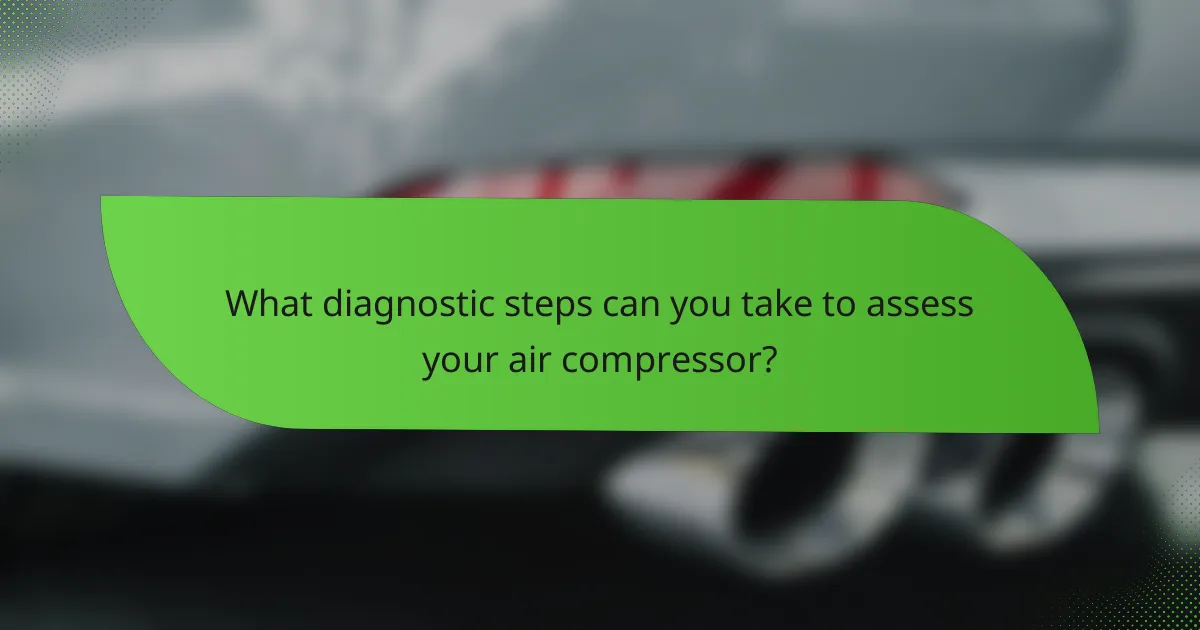
What diagnostic steps can you take to assess your air compressor?
To assess your air compressor, start by checking for air leaks. Inspect all hoses and connections for any signs of wear or damage. Next, listen for unusual noises during operation. Sounds like rattling or hissing may indicate internal issues. Monitor the pressure gauge for consistent readings. Fluctuations can suggest a malfunctioning regulator. Additionally, examine the oil level and quality if it’s an oil-lubricated compressor. Low or dirty oil can affect performance. Finally, review the air filter condition. A clogged filter can impede airflow and efficiency. Regularly performing these diagnostic steps can help maintain optimal compressor function.
How do you perform a basic inspection of your air compressor?
To perform a basic inspection of your air compressor, start by checking for any visible leaks. Inspect hoses and fittings for wear or damage. Next, examine the air filter for dirt and debris; a clean filter ensures optimal performance. Then, check the oil level if your compressor uses oil; low oil can lead to engine damage. After that, listen for unusual noises during operation, which can indicate mechanical issues. Finally, verify that all safety features, like pressure relief valves, are functioning properly. Regular inspections can prevent costly repairs and extend the life of your air compressor.
What tools do you need for a thorough diagnostic check?
You need a pressure gauge, multimeter, and air leak detector for a thorough diagnostic check. A pressure gauge measures the air pressure in the compressor system. A multimeter checks electrical components and connections for faults. An air leak detector identifies any leaks in the system. These tools are essential for assessing the performance and integrity of the air compressor. Proper diagnostics ensure efficient operation and prolonged lifespan.
How can you check for leaks in your air compressor system?
To check for leaks in your air compressor system, use a soap and water solution. Apply the solution to all connections, hoses, and fittings. Look for bubbles forming, which indicate escaping air. Inspect the compressor tank and check for rust or corrosion. Listen for hissing sounds while the compressor is running. A drop in pressure on the gauge can also signal a leak. Regularly inspecting these areas helps maintain system efficiency.
What tests can help you determine the condition of your air compressor?
To determine the condition of your air compressor, several tests can be conducted. Performing a pressure test reveals if the compressor maintains adequate pressure levels. A leak test checks for air leaks in hoses and fittings. An oil analysis assesses the quality and condition of the lubricant. A temperature test monitors the compressor’s operating temperature for overheating issues. Lastly, a vibration analysis identifies mechanical wear or imbalance. These tests provide essential insights into the operational state of the air compressor.
How do you evaluate the performance of the motor?
To evaluate the performance of the motor, measure its efficiency and output. Efficiency can be calculated by comparing the input power to the output power. A well-performing motor typically has an efficiency rating between 85% to 95%. Output can be assessed by checking the motor’s speed and torque against its specifications.
Additionally, monitor the motor’s temperature during operation. A temperature rise above 20 degrees Celsius from ambient conditions may indicate issues. Conduct vibration analysis to detect mechanical imbalances. Excessive vibrations can signify wear or misalignment.
Regularly inspect electrical connections and ensure they are secure. Poor connections can lead to power loss and reduced performance. Finally, analyze the motor’s sound during operation. Unusual noises may indicate mechanical problems. These methods collectively provide a comprehensive evaluation of motor performance.
What should you monitor during a pressure test?
During a pressure test, you should monitor the pressure gauge readings. Ensure that the pressure remains stable over time. Check for any pressure drops, which indicate leaks. Observe the temperature of the system during the test. Monitor for unusual noises that may suggest mechanical issues. Inspect the connections and seals for signs of wear or damage. Record any fluctuations in pressure levels throughout the test. These monitoring steps help ensure system integrity and safety during the pressure test.

What timely actions should you take when maintenance is needed?
When maintenance is needed for your air compressor, promptly check for any visible leaks or unusual noises. Inspect the air filter and clean or replace it if it is dirty. Verify the oil levels and add oil if necessary to ensure proper lubrication. Tighten any loose fittings or connections to prevent air loss. Test the pressure gauge for accuracy and replace it if it is malfunctioning. Lastly, schedule a professional inspection if problems persist, as this can prevent further damage. Regular maintenance can extend the lifespan of the compressor and improve its efficiency.
How can you effectively clean and lubricate your air compressor?
To effectively clean and lubricate your air compressor, start by disconnecting it from the power source. Remove any debris from the exterior using a soft brush or cloth. Drain the air tank to eliminate moisture buildup, which can cause rust. Check and clean the air filter, replacing it if necessary.
Next, inspect the oil level in the compressor. If it’s low, add the appropriate oil type as specified in the user manual. Run the compressor briefly to circulate the oil, ensuring proper lubrication of internal components. Regular maintenance, including cleaning and lubrication, can extend the lifespan of your air compressor significantly.
What specific maintenance tasks should be performed regularly?
Regular maintenance tasks for a DIY air compressor include checking and changing the oil. This ensures optimal performance and prevents engine wear. Additionally, it is essential to clean or replace the air filter regularly. A clean filter promotes efficient airflow and extends the compressor’s lifespan. Inspecting and tightening all bolts and fittings is crucial to prevent leaks. Regularly draining the moisture from the tank helps avoid corrosion and ensures safety. Testing the pressure relief valve ensures it functions correctly, preventing potential hazards. Lastly, checking the hoses for wear and tear is vital to maintain safe operation. These tasks collectively contribute to the longevity and efficiency of the air compressor.
How often should you replace filters and oil?
Replace air compressor filters every 3 to 6 months. This frequency ensures optimal performance and prevents dust and debris buildup. Oil should be changed every 500 to 1,000 hours of operation or annually, depending on usage. Regular maintenance extends the life of the compressor. Following these guidelines helps maintain efficiency and reduces the risk of breakdowns.
What are some common troubleshooting tips for DIY air compressor issues?
Check the power supply first. Ensure the compressor is plugged in and the outlet is functional. Inspect the power cord for any damage. If the compressor does not start, check the circuit breaker.
Listen for unusual noises. If the compressor is noisy, inspect the motor and pump for loose parts. Tighten any loose screws or bolts. Lubricate moving parts if necessary.
Examine the pressure gauge. If it reads inaccurately, check for leaks in the system. Use soapy water to identify any leaks around fittings and hoses. Replace any damaged components.
Monitor the air pressure. If the compressor fails to build pressure, check the intake filter. Clean or replace the filter if it is clogged. Inspect the unloader valve for proper operation.
Inspect the tank for rust or corrosion. If there are signs of wear, consider replacing the tank. Regular maintenance can prevent these issues.
Review the manual for specific troubleshooting steps. Each model may have unique requirements. Following the manufacturer’s guidelines ensures proper care.
How can you resolve pressure drops effectively?
To resolve pressure drops effectively, identify and fix leaks in the air system. Leaks can significantly reduce pressure and performance. Inspect hoses, fittings, and connections for any signs of wear or damage. Tighten loose fittings to prevent air loss. If necessary, replace damaged components to restore integrity. Additionally, ensure that the air filter is clean and unobstructed. A clogged filter can restrict airflow and contribute to pressure drops. Regular maintenance checks can help identify these issues early, ensuring optimal compressor performance.
What steps should you take if your air compressor won’t start?
Check the power supply to your air compressor first. Ensure it is plugged in and the outlet is functioning. Inspect the power cord for any visible damage. Verify that the circuit breaker has not tripped. If the compressor has a reset button, press it. Examine the pressure switch for proper operation. Ensure that the tank pressure is below the cut-in pressure. If these steps do not resolve the issue, consult the user manual for further troubleshooting.
The main entity of this article is the DIY air compressor. The article outlines the signs indicating that a DIY air compressor requires maintenance, such as unusual noises, decreased pressure, oil leaks, and circuit breaker tripping. It details common indicators and diagnostic steps to assess the compressor’s condition, including visual inspections and performance tests. Additionally, it emphasizes the importance of regular maintenance to enhance efficiency and extend the compressor’s lifespan while offering troubleshooting tips for common issues. Timely actions for maintenance and specific tasks to perform regularly are also highlighted to ensure optimal performance.
